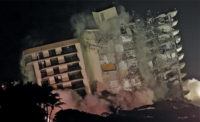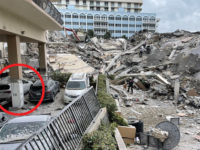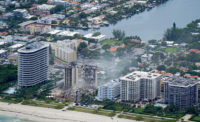Sources indicate that at about 10:30 p.m. on the Fourth of July, Controlled Demolition Inc. will implode the damaged 12-story remaining wing of the reinforced concrete Champlain Towers South condominium in Surfside, Fla. CDI has been working with demolition contractor BG Group to prepare the unstable wing for implosion since July 3, when search and rescue operations ceased.
Part of the L-in-plan residential building collapsed in a matter of seconds on June 24, at about 1:30 a.m. As of July 3, there were 24 fatalities and 124 people unaccounted for, according to Miami-Dade County Mayor Daniella Levine Cava.
Levine Cava said in a press briefing on July 3 that the state government will be paying for the demolition. "The contract has been signed for the demolition to begin," she said.
The implosion is designed so that the building will not land on the debris pile. Also, it will be done to avoid Collins Avenue, to the west. Explosives will be loaded before noon July 3. Preparations are in the lobby and basement only. No one is allowed above the lobby level.
Wind Load Model Calculates Tolerance
On Friday night, July 2, KCE Structural Engineers finished its wind load model of the partially collapsed north end of the remaining wing. The modeling was based on the 1979 drawings for the building. The north end is expected to be able to withstand wind gusts of 65 mph and sustained winds of 40 mph, with a safety factor of 1, says Allyn Kilsheimer, founder, president and CEO of KCE.
Kilsheimer has been investigating the collapse, including gathering evidence, for the town of Surfside since June 25. Samples of concrete for analysis have been sent to Wiss Janney Elstner Associates Inc. Samples of reinforcing steel have been sent to Metallurgical Technologies-Rimkus and samples of the debris have been sent to a laboratory for environmental analysis to determine if there are any contaminants, says Kilsheimer.
Regarding the cause of the collapse, Kilsheimer says KCE, working with geotechnical engineer Mueser Rutledge Consulting Engineers, which is studying the geology, is considering every possibility and every suggestion offered, mostly via email, from hundreds of people all over the nation. "We are looking at everything and anything," he says. The team is even considering the plausibility of the impact of the U.S. Navy's June 18 trial explosive charge in the Atlantic Ocean, 100 miles off the coast of Florida, which triggered a magnitude-3.9 earthquake.






Post a comment to this article
Report Abusive Comment